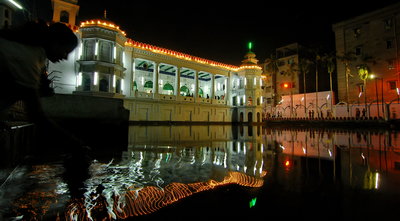
The HussainiDalan was originally built during the latter half of the Mughal rule (17th century) in Dhaka. It was built as the Imambara or house of the Imam (religious leader) of the Shia Muslim Community. Hussaini Dylan serves as the main Hussainiya of Dhaka, of venue for majlis or gatherings held during the month of Muharram, tenth-day religious gathering commemorates the martyrdom of Hussain, the grandson of the Islamic prophet Muhammad.
Hussaini Dylan is a Shiite visiting place and Imambara in the old city of Dhaka in Bangladesh. It dates back to the late period of the Gurkani dynasty. The general structure of the building is modeled after Imam al Husain’s (a) mausoleum and tazia. Every year in the first ten days of Muharram month, it turns into the most hectic place in the city.
History of Hussaini Dalan :
According to Taylor (1839, The principal Mahommedan places of worship are the Edgar HossaineeDelaun, the latter is said to have been built By a person named Mir Murad, who held the Darogahship of the Nawarrah Metals, and had charge of the public buildings In the time of Sultan Muhammad Azam.
It was built during the Subedari of Prince Shah Shuja (r. 1639-1647 and 1652-1660). Son of Mughal emperor Shah Jahan. Although Shuja was a Sunni Muslim, he patronized Shia institutions too. According to tradition, “Mir Murad had a vision of ImamHussain erecting a ‘taziakhana’ or house of the morning which led to the construction of HussainiDalan.
Raised on the foundations of a former small taziakhana, the building has undergone alterations. During the rule of the East India Company. It was repaired in 1807 and 1810. The original date of construction is still disputed, but HussainiDalan in its present form is attributed to Nusrat Jung, who rebuilt the Imambara in 1823. The present flat roof was rebuilt by NawabAhsanullahBahadur after the earth quack of 1897, and another veranda was added to the southern side.
The building was apparently constructed in the middle of the 11th/17th century by a person called “Mir Murad” who was the sheriff of the town and in charge of constructing public buildings in the strip of the area. However, according to Badawi, in the 10thy/16th and 11th/17th centuries, the Shias held morning ceremonies of Muharram secretly in their houses and the title, “HussainiDalan” was given to the building early in the 12th/18th century during the reign of MurshidQuli Khan and the and the building turned into a center for the ceremonies of the Muharram month in Bengal.
Hussaini Dalan Ticket Price:
There’s no entry fee. Open for all.
Hussaini Dalan Opening Hour:
HussainiDalan is open at 7:00 am.
Hussaini Dalan Off Day:
There’s no off day at all.
Contact Number:
Phone: 01991-659950
Address, Location (How To Go):
Dhaka City, Bangladesh. You can reach old Dhaka by taking local transport from any part of Dhaka city.
Most Attractive Things (What you Can See There):
This building has gone through several renovations and none of its antiquity left for the visitors. People only used to visit this place for its historical place. During the British period, it was repaired heavily in 1807 and 1810. Also during the massive earth quack of 1897 caused severe damage over this edifice.
Nowadays it just looks like a modern-day building cover with rich tiles with heavy ornate. The photograph was taken by Fritz Kapp in 1904 with a view of the ImambaraHussainiDalan in (Dacca) nom Dhaka.
During the first ten days of Muharram. Shia people used to gather at this place to mourn for Al-Hussain. Through its festival of Shia people, but local Sunni people used to join with them and bemoan with them. This ends on the day of Ashura.
From the first to the tenth day of Muharram, the HussainiDalan becomes the chief attraction of the city. Mourners, including Sunni Muslims, assemble there, listen to semons and join in passion place crying ‘Ya Husain, Ya Husain’. On the Ashura 10th day, great procession parades through the main streets of the city to a place in the western part of the city symbolically called Karbala.